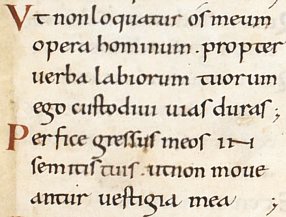Script Type : minuscule
Date : 8th to 12th centuries; this example is early 11th century
Location : France, Germany, England, Spain, northern Italy, Scandinavia; this example is from England
Function : Book hand and basis for document hands























Distinctive letters : Once you manage the tall s and the short t, the rest of this is easy as all the letters are of familiar form.
There are no examples of j, k, w, y or z in this example.
While Caroline minuscule largely dispensed with the multitude of confusing ligatures that made the reading of pre-Carolingian scripts so difficult, it introduced two of its own,
ct  and st
and st  . These were to prove an enduring idiosyncrasy of the script. See the words custodiui and uestigia above.
. These were to prove an enduring idiosyncrasy of the script. See the words custodiui and uestigia above.
The letter, ligature, abbreviation (or whatever you want to call it) æ appears as an e with a fancy diagonal tail. This appears as a colour graphic as there wasn't one in the original black and white photograph of a section of the page. So you now get an extra letter.
Note the insertion of majuscule script in the word IN; a peculiar formality sometimes encountered.
The script is neat, the letters well separated, the words clearly separated and there are no abbreviations. It's hardly paleography at all!
Run the cursor slowly over the lines of text for a quick fix on it. For a more detailed examination, work through the paleography exercises.
Paleography
Exercises using Flash ![]()
Requires at least the Flash 5 plugin
If you are looking at this page without frames, there is more information about medieval writing to be found by going to the home page (framed) or the site map (no frames).